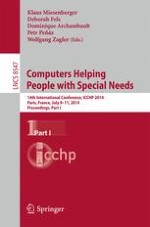The two-volume set LNCS 8547 and 8548 constitutes the refereed proceedings of the 14th International Conference on Computers Helping People with Special Needs, ICCHP 2014, held in Paris, France, in July 2014. The 132 revised full papers and 55 short papers presented were carefully reviewed and selected from 362 submissions. The papers included in the first volume are organized in the following topical sections: accessible media; digital content and media accessibility; 25 years of the Web: weaving accessibility; towards e-inclusion for people with intellectual disabilities; the impact of PDF/UA on accessible PDF; accessibility of non-verbal communication; emotions for accessibility (E4A), games and entertainment software; accessibility and therapy; implementation and take-up of e-accessibility; accessibility and usability of mobile platforms for people with disabilities and elderly persons; portable and mobile platforms for people with disabilities and elderly persons; people with cognitive disabilities: At, ICT and AAC; autism: ICT and AT; access to mathematics, science and music and blind and visually impaired people: AT, HCI and accessibility.
